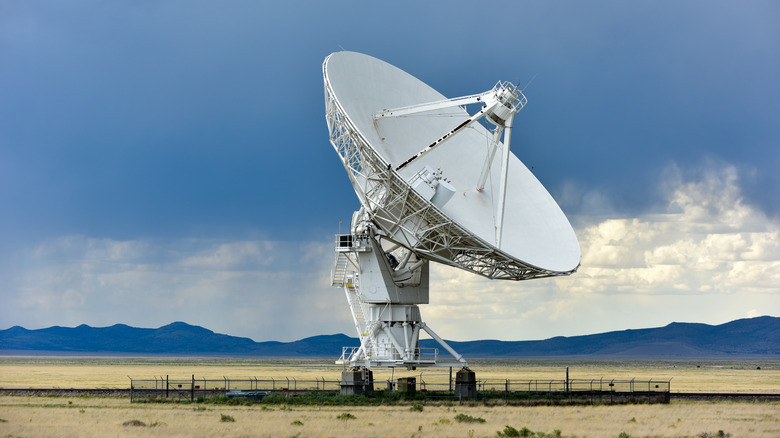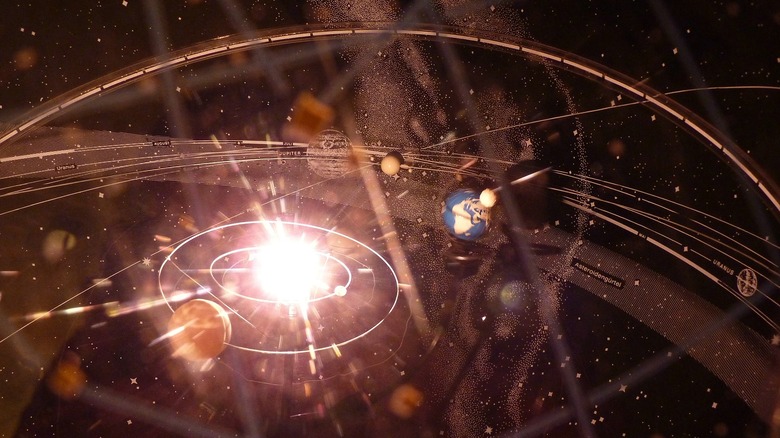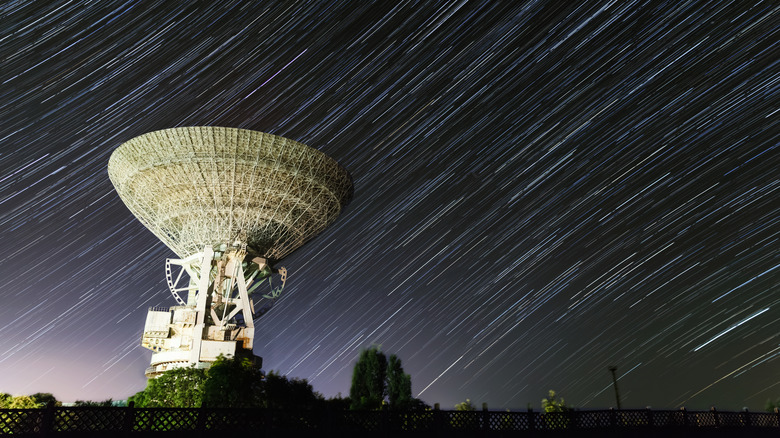Scientists Think We Could Use These Techniques To Send Directions To Aliens
People have been wondering if life exists elsewhere in the universe for over 2,000 years. In the third century B.C. the Greek philosopher Epicurus pondered that if there were infinite worlds — could one exist like ours? Could there be life out there on other worlds (via Astronomy)?
His ideas were echoed by the Roman writer Lucretius just before the fall of the Republic. However, due to the influence of Aristotle and the Church, the idea of other people on other worlds wasn't talked about with any earnestness until the Copernican revolution dislodged Earth from the center of the universe, as The MIT Press Reader notes.
Around the turn of the 20th century, Percival Lowell caused a sensation when he reported numerous canals on the surface of Mars (after studying the observations of Italian astronomer Giovanni Schiaparelli), launching the idea of extraterrestrial life into the popular consciousness. In the 1960s, Frank Drake began scanning the skies with radio telescopes, a search that continues today in the SETI program (via SETI).
Ever since speculation about extraterrestrial life has left the fringes of science, some have turned their thoughts from searching for alien life, to actively sending messages. But, what do you put in those messages? And, in particular, how do you tell the eventual recipient of your message where to find you?
Lighthouse in the sky
The most obvious method of telling someone where you are is with a beacon. If you're a bluff on a wind-swept coastline, the best beacon for you is a lighthouse. If you're a castaway on a boat adrift in the sea, the best beacon for you is a flare gun. And, if you're on a rock, hurtling through the galaxy at nearly 500,000 miles per hour and you want someone on another rock to know where you are, your best beacon is a radio broadcast.
This idea is simple but it has a basic problem. The issue is the way electromagnetic waves propagate through space. As radio waves travel away from their point of transmission, the strength of their signal decreases at an exponential rate. That means you have to have a lot of power if you want anyone to see your beacon. One solution to this problem is to use a polarized laser for a signal which won't degrade as fast. The downside to using a high-powered laser as a beacon is that it is hyper-focused. If you don't have a target or it's not aimed precisely, no one will see your beacon (via Live Science).
Celestial triangulation
If you don't fancy leaving the lights on for your celestial neighbors, you could opt to send them our address instead. But, how do you tell your new alien friends where you live? There are no street signs or house numbers in space so you'll need another frame of reference if you want Earth to be found.
The key to solving this problem hit upon by Frank Drake was pulsars, a type of neutron star that gives off flares of electromagnetic radiation at regular intervals. Drake made a map of our corner of the galaxy showing the relative position of our sun from 14 pulsars. He then noted the frequency of the pulsars' emissions so they could be identified (via PBS).
One thing that Drake didn't account for was just how many pulsars are in the galaxy. When he first made his map in 1971, pulsars had only been discovered four years earlier. Today we know that there are about a billion pulsars in our galaxy, making it nearly impossible to isolate just 14 (or 0.0000014%) of them, according to Forbes.
To address this problem, scientists are proposing to instead give the sun's position relative to globular clusters, as Scientific American reports. Unlike the vast multitude of pulsars in the galaxy, the number of globular clusters in the Milky Way is only in the hundreds.
Megastructures
One way to ensure someone knows where you live is to make your home impossible to miss. In the case of your house that might mean painting it bright pink or leaving your Christmas lights on all year. In the case of the Earth we might want to build something so big that it changes the way our sun looks from other worlds.
Some of the earliest proposals for Earth-based beacons took the form of enormous engineering projects like drawing the Pythagorean theorem in Siberian pine forests or setting massive trenches ablaze in the Sahara. Something so big and obviously artificial it couldn't be mistaken for anything other than an intentional construction (via Forbes).
One structure that would be impossible to miss is a Dyson sphere — a colossal engineering project that would enclose a star, capturing 100% of its radiated energy. Such a structure would have an unmistakable infrared signature. Scientists are already theorizing about how we could detect enormous structures like Dyson spheres in other star systems using currently available orbital telescopes (via arXiv).
Message in a bottle
The first message intentionally sent into space was largely a symbolic affair. In 1962, Soviet scientists beamed a message to Venus in Morse code with three words: peace, Lenin, and the initials for the Soviet Union, as Wired notes.
In the 1970s physical messages were sent out with four satellites — two with Pioneer 10 and 11, and two with Voyager 1 and 2. The Pioneer probes were sent out with plaques attached to them with visual depictions of hydrogen, our solar system, and human figures. The messages sent with the Voyager probes were golden records with samples of sounds, greetings, and songs from around the world as well as a number of images encoded as audio.
The 1970s are also when we sent the most powerful radio message into space. Known as the Arecibo Message, it was sent to a cluster of stars near the center of the galaxy and will arrive in around 25,000 years. More recently, the Cosmic Call was sent out from a satellite dish in Crimea to nine different stars.
Turn off the lights
For hundreds of years, we've been thinking about how to contact an extraterrestrial intelligence or what to say to them. We've come up with clever ways of overcoming interstellar language barriers and sharing our location with anyone in the galaxy, but some scientists are beginning to wonder if that's such a wise idea.
The opponents of reaching out to possible alien life emphasize that we don't know the intentions or motivations of potential visitors to our planet, precisely because they would be alien. Anyone we do contact is likely to be much more technologically advanced than we are and thus we would be powerless against their whims (via The New York Times).
Proponents of messaging alien life argue that it's an exercise in futility to try and hide our location now that we've been leaking radio waves into the universe for over 50 years. And, do we really want "I Love Lucy" to be the sum of our contact with alien intelligence?





